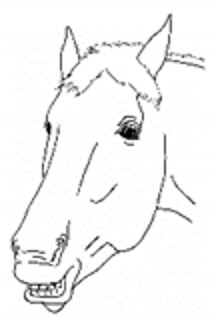Groundbreaking work from University of Pennsylvania researchers takes some of the guesswork out of determining whether horses are in pain.
The Equine Discomfort Ethogram, a detailed catalog of equine postures and behaviors, was compiled based on a review of research data and consultation records for horses treated at the university’s veterinary hospital going back 35 years.

With diagrams, photographs and videos, the researchers hope to help veterinarians and horse owners to better recognize and interpret the often-subtle signs of pain in horses.
“We had two main reasons for publishing the ethogram in this form,” says Catherine Torcivia, VMD, a University of Pennsylvania research associate who assisted Sue McDonnell, PhD, with the project. “The first is to increase recognition of discomfort in horses by providing an educational resource. The second is to provide a ‘dictionary’ of behaviors that can provide a basis for universal communication across cultures when discussing discomfort in horses.”
Along with the hospital’s case records, the researchers had access to thousands of hours of continuous 24-hour video recordings of horses at the clinic. Videos of normal, healthy horses were reviewed along with those of horses admitted for various complaints or health problems, such as colic, neurologic disease and orthopedic conditions.
In many cases, the researchers were able to catalog behaviors before and after pain medications were administered, and/or they followed up with the treating veterinarian to link the behaviors observed to diagnosis of disease in various body systems. All of this allowed the researchers to confirm which behaviors likely indicated discomfort. The researchers also performed an extensive search of veterinary and behavior studies describing pain-related behaviors in order to crosscheck their own findings, as well as to identify behaviors they may have overlooked.
The resulting list of 64 behaviors is grouped into eight categories: posture and weight-bearing; limb and body movements; head, neck, mouth and lip movements; attention to an area; ear and tail movements; overall demeanor; altered eating or drinking; and vocalizations/audible sounds. Each entry includes the name of the behavior and a description, a line drawing and—in all but one instance—a link to video showing the behavior.
“Having all of these behaviors named, defined and illustrated is essential to getting everyone on the same page when discussing discomfort in horses,” says Torcivia. “We believe this document is unique in its thoroughness in clearly describing and illustrating each behavior.”
The full ethogram, with all drawings and videos, is available to the public as part of the open-access paper published online (see reference at the end of this article). Horse owners and veterinarians can use the information to learn more about discomfort behaviors in general or to research a specific behavior a horse is currently displaying, says Torcivia. “Increasing awareness of these behaviors may help in earlier recognition of discomfort in horses before noticeable changes in performance or the development of severe disease occurs,” she says. “Then when you are assessing horses in a specific situation, you can monitor these behaviors for a variety of reasons, such as localizing discomfort or tracking effectiveness of analgesia.”
That said, Torcivia emphasizes a horse’s behavior needs to be considered in context. “Some are normal in certain situations, in the sense that they may reflect transient superficial irritation,” she says. “The examples I commonly talk about are behaviors like stomping and tail swishing. In hot weather when flies are present, these behaviors are normal and expected. However, if you saw a horse repeatedly stomping or swishing its tail on a cold winter day when no biting insects are present, you would have more reason to explore physical discomfort as a cause.”
Reference: “Equine Discomfort Ethogram,” Animals, February 2021
____________________________
Don’t miss out! With the free weekly EQUUS newsletter, you’ll get the latest horse health information delivered right to your in basket! If you’re not already receiving the EQUUS newsletter, click here to sign up. It’s *free*!








